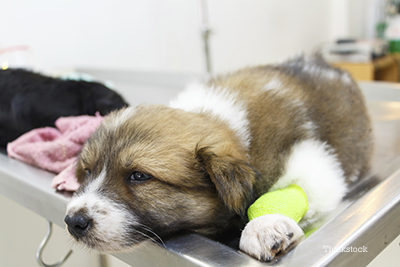
Dr. Justine Lee discusses when it's a good idea to take your dog the the emergency veterinarian... and when it's not. For signs that your cat should visit the ER, click here.
Alright, raise your hand if you don’t mind getting up at 2 A.M. to bring your dog in to the emergency veterinarian.
Didn’t think so.
Often times, as a pet owner, it’s hard to know whether your dog’s condition is a true medical emergency or not… or more importantly, if it warrants getting up in the middle of the night to seek medical attention from a veterinary professional you don’t know.
As an emergency critical care veterinary specialist, I’ll be honest in saying that some emergencies can wait to see your regular veterinarian the following morning (like diarrhea, midnight health certificates, itchy skin, urinary tract infections, etc.). However, there are certain situations where it is imperative that your dog go in to the animal ER, as sometimes it can be a potentially fatal problem without treatment.
I’ve seen a lot of emergencies that could have waited, but the pet owners were concerned enough that they didn’t mind the 2 A.M. visit, as it gave them peace of mind. Unfortunately, I’ve also seen some sad cases where pet owners waited too long, only to have animals die as they are being wheeled into the ER. It’s not worth chancing that you wake up to find your dog deceased in the middle of the night. In fact, no dog or cat should ever die at home, but that’s a whole other blog that I’ll elaborate on in the future.
Some signs that warrant you getting up in the middle of the night and getting to an emergency vet ASAP include:
- Difficulty breathing, which may be manifested as blue gums, coughing of foamy, pink frothy liquid, panting constantly, or stretching the head and neck out while breathing
- Constant coughing and inability to rest through the night
- A distended, “bloated” abdomen
- Non-productive retching (which is classic for gastric-dilitation volvulus or “GDV”)
- Anxiety or restlessness (often a sign of pain or a GDV)
- Pale gums (which is often seen with internal bleeding or anemia)
- An elevated heart rate (> 160 beats per minute at home)
- A respiratory rate of > 60 breaths per minute at home while resting
- Crying out in pain
- Jaundiced (yellow gums)
- Not being able to move or walk or dragging of the back legs
- Extreme lethargy
- Any significant amounts of bleeding
- Any trauma
- Any poisoning or toxin ingestion
- Vomiting more than two or three times
- Abnormal vaginal discharge
- Abnormal odor from your dog
- Fever
- Squinting, bulging, or painful eyeballs
- Straining to urinate, making multiple trips to urinate, squatting to urinate without producing any urine
- Collapse
- Anything that makes you worried
- Tremors or seizures
- Any abnormal behavior that you’re worried about (e.g., acting aloof or particularly clingy)
(Fear not, cat owners, I’ll have a different list for you soon!)
While this list isn’t all-inclusive, it gives you a good general idea to work with. When in doubt, call your veterinarian or emergency veterinarian, as the receptionist or veterinary technician may be able to help guide you and “phone triage” you (although they are obviously always going to bear on the side of caution). Also, keep in mind that the sooner you diagnose and treat a problem, the less expensive it often is.
If you do bring your dog in to the ER, make sure to bring a book or computer; just like a human ER, there is often a several hour wait to be seen, and at 2 a.m., some of your fellow humans are going to be less than appealing conversationalists.
When in doubt, if you’re concerned, bring ‘em in, because you know your dog the best. The time is a small sacrifice for your dog’s health and your piece of mind.
If you have any questions or concerns, you should always visit or call your veterinarian – they are your best resource to ensure the health and well-being of your pets.
